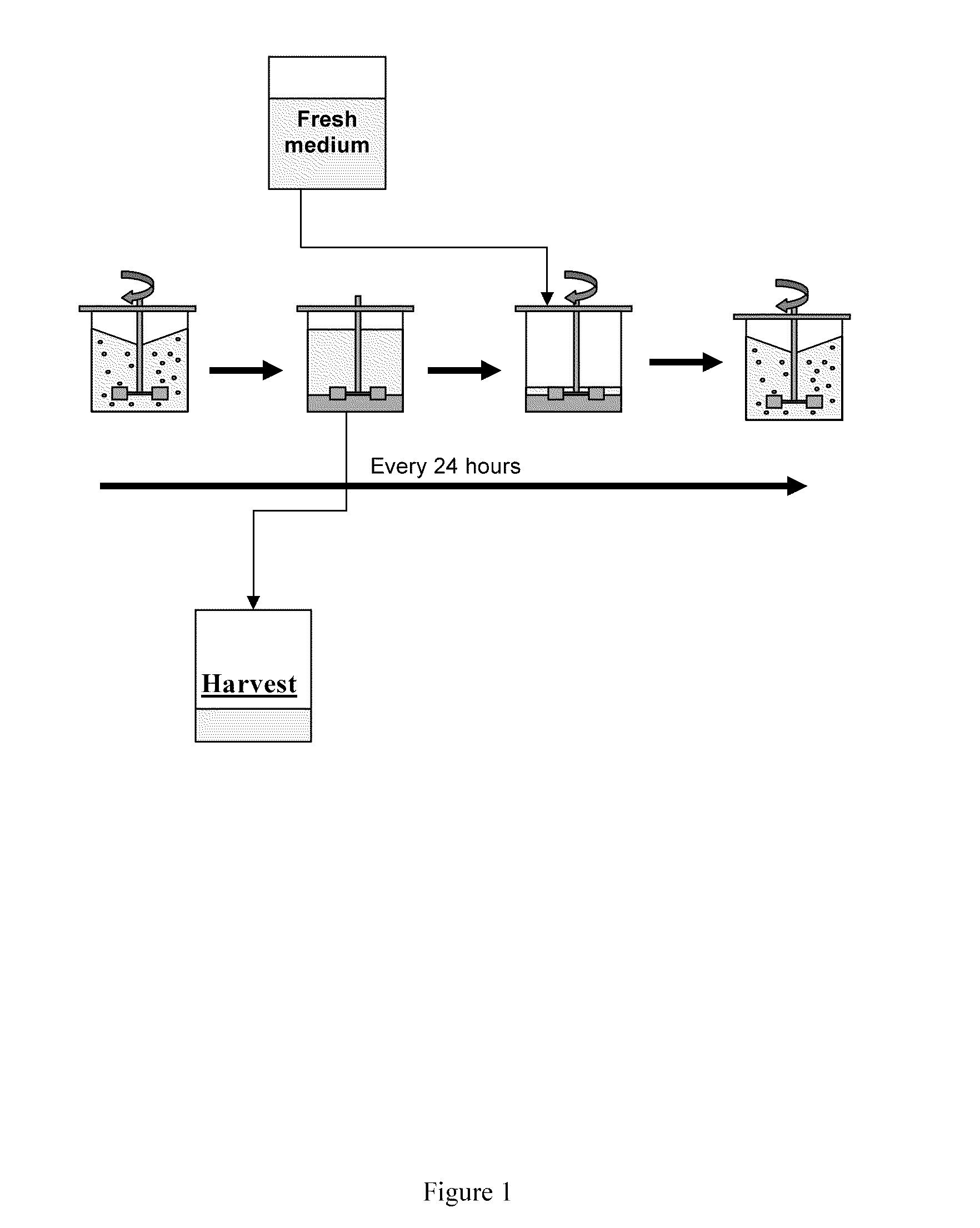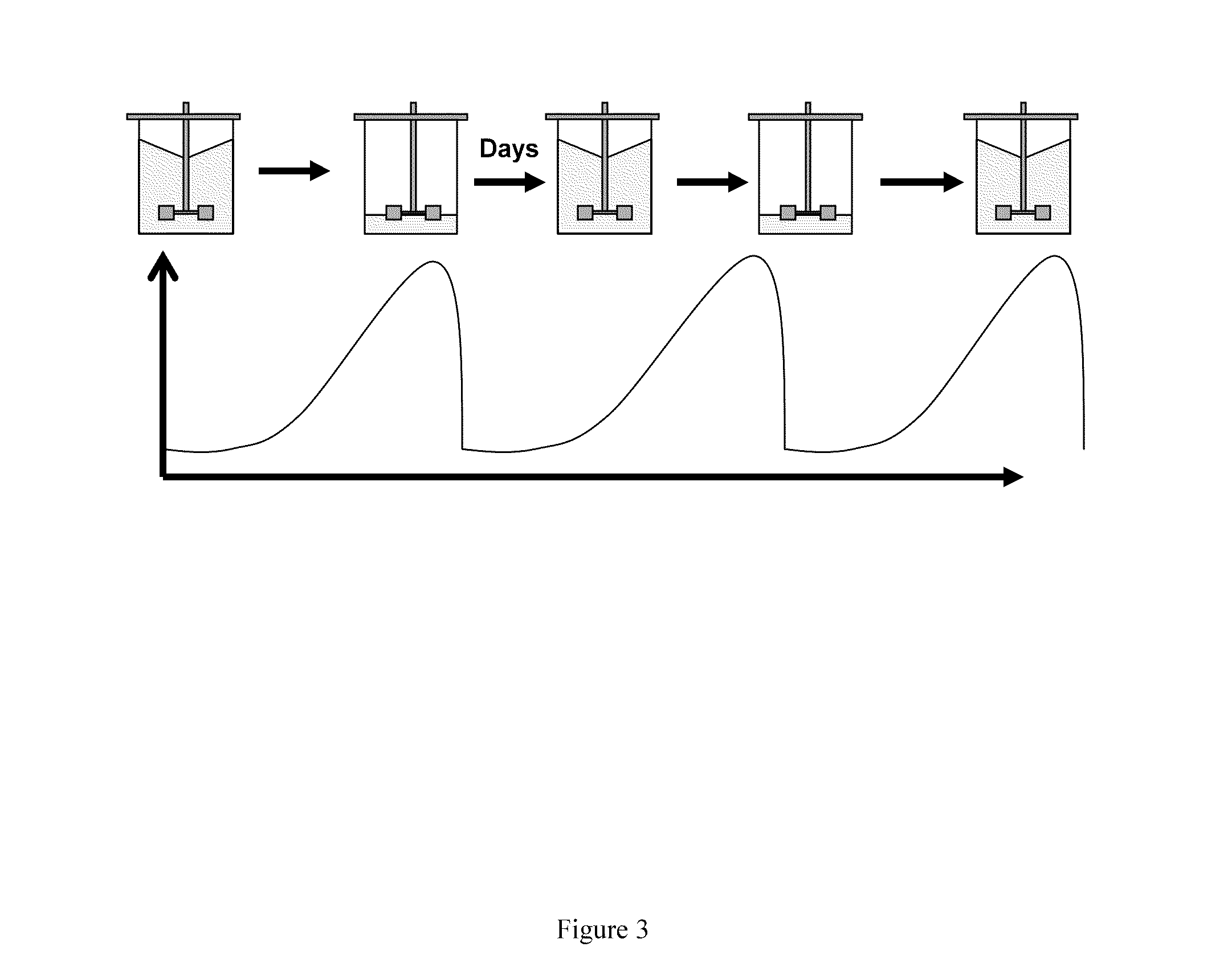Industrial-scale Serum-free Production of Recombinant Factor VII in Mammalian Cells
a technology mammalian cells, which is applied in the field of serum-free production of recombinant factor vii in mammalian cells at industrial scale, can solve the problems of difficult cell culture in absence of serum from initiation of culture until large-scale production volume, and achieve high-level production
- Summary
- Abstract
- Description
- Claims
- Application Information
AI Technical Summary
Benefits of technology
Problems solved by technology
Method used
Image
Examples
example 1
Serum-Free Production of Factor VII
[0214]The following experiment was performed to produce Factor VII in large-scale culture.
[0215]A BHK cell line transfected with a Factor VII-encoding plasmid was adapted to growth in suspension culture in the absence of serum. The cells were adapted to serum-free suspension culture and were propagated sequentially in spinner cultures; as the cell number increased, the volume was gradually increased by addition of new medium.
[0216]Finally, 6 l of seed culture were inoculated into a 100-liter production bioreactor containing macroporous Cytopore 1 carriers (Pharmacia), after which the suspension cells became immobilized in the carriers within 24 hours after inoculation. The culture was maintained at 36° C. at a pH of 6.7-6.9 and a Dissolved Oxygen Tension (DOT) of 50% of saturation. The volume in the production bioreactor was gradually increased by addition of new medium as the cell number increased. When the cell density reached approximately 2×106...
example 2
Serum Free Production of Factor VII
[0218]The following experiment was performed to produce Factor VII in large-scale culture.
[0219]A plasmid vector pLN174 for expression of human FVII has been described (Persson and Nielsen. 1996. FEBS Lett. 385: 241-243). Briefly, it carries the cDNA nucleotide sequence encoding human FVII including the propeptide under the control of a mouse metallothionein promoter for transcription of the inserted cDNA, and mouse dihydrofolate reductase cDNA under the control of an SV40 early promoter for use as a selectable marker.
[0220]For construction of a plasmid vector encoding a gamma-carboxylation recognition sequence, a cloning vector pBluescript II KS+(Stratagene) containing cDNA encoding FVII including its propeptide was used (pLN171). (Persson et al. 1997. J. Biol. Chem. 272: 19919-19924). A nucleotide sequence encoding a stop codon was inserted into the cDNA encoding FVII after the propeptide of FVII by inverse PCR-mediated mutagenesis on this clonin...
example 3
Serum Free Production of Factor VII
[0227]The following experiment was performed to produce Factor VII in large-scale culture.
[0228]A high producing CHO clone was made as described in Example 2
[0229]The adapted cells were propagated sequentially in spinner cultures and as the cell number increased, the volume was gradually increased by addition of new medium.
[0230]After 25 days, 6 l of spinner culture were inoculated into a 50-liter bioreactor. The cells were propagated in the bioreactor and as the cell number increased, the volume was gradually increased by addition of new medium.
[0231]Finally, 50 l of seed culture were inoculated into a 500-liter production bioreactor containing macroporous Cytopore 1 carriers (Amersham Pharmacia Biotech), after which the suspension cells became immobilized in the carriers. The culture was maintained at 36° C. at a pH of 7.0-7.1 and a Dissolved Oxygen Tension (DOT) of 50% of saturation. The volume in the bioreactor was gradually increased by additi...
PUM
| Property | Measurement | Unit |
|---|---|---|
| Fraction | aaaaa | aaaaa |
| Fraction | aaaaa | aaaaa |
| Fraction | aaaaa | aaaaa |
Abstract
Description
Claims
Application Information
 Login to View More
Login to View More - R&D
- Intellectual Property
- Life Sciences
- Materials
- Tech Scout
- Unparalleled Data Quality
- Higher Quality Content
- 60% Fewer Hallucinations
Browse by: Latest US Patents, China's latest patents, Technical Efficacy Thesaurus, Application Domain, Technology Topic, Popular Technical Reports.
© 2025 PatSnap. All rights reserved.Legal|Privacy policy|Modern Slavery Act Transparency Statement|Sitemap|About US| Contact US: help@patsnap.com



